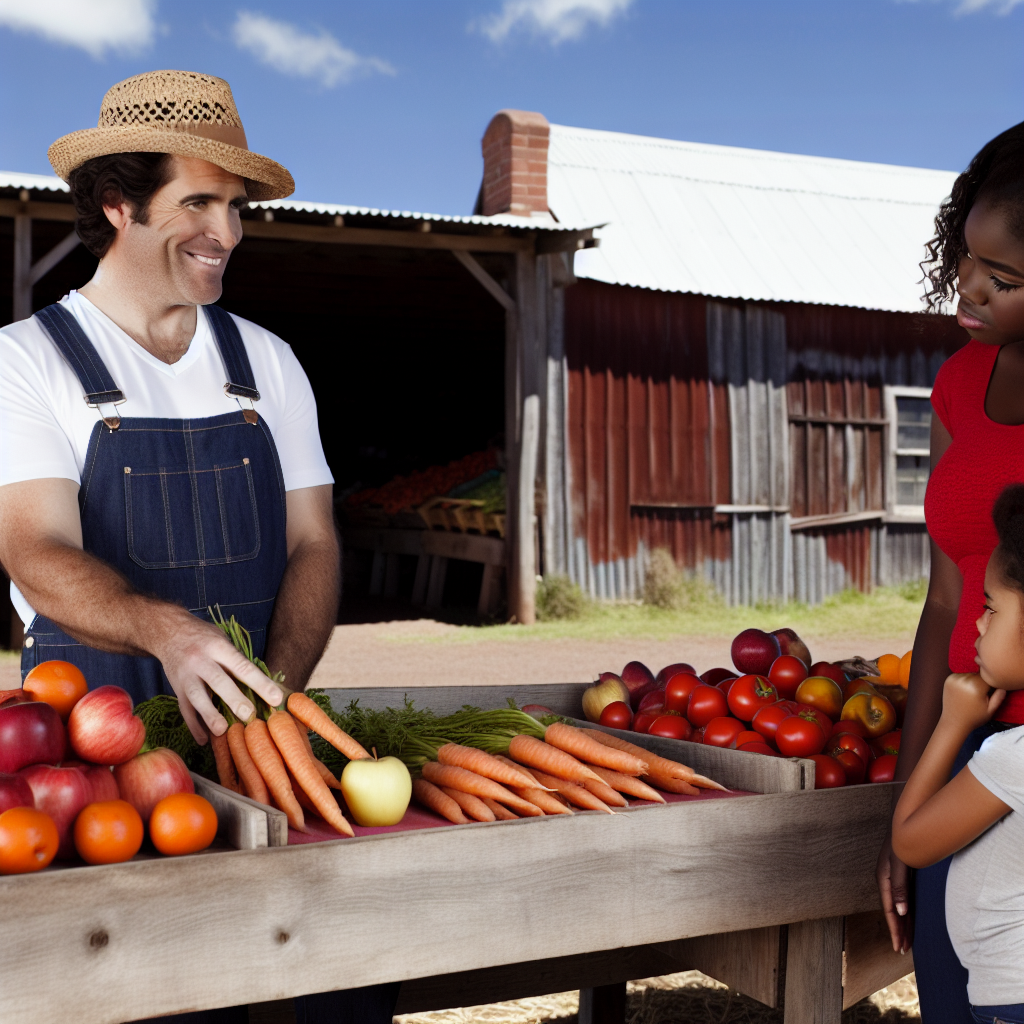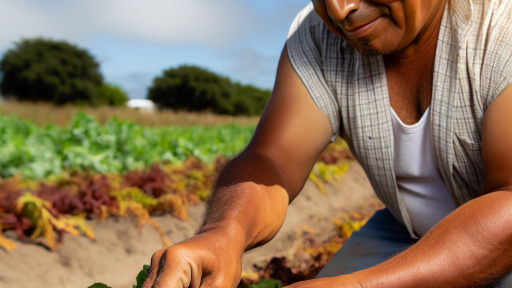Introduction to Direct-to-Consumer Farming
Direct-to-consumer farming connects farmers directly with consumers.
This model enhances the relationship between producers and buyers.
Farmers can sell fresh produce, livestock, and other goods directly.
This approach often leads to better prices for both parties.
Additionally, consumers receive fresh and locally sourced products.
Benefits of Direct-to-Consumer Farming
This farming model offers numerous advantages.
Firstly, farmers enjoy higher profit margins.
They can eliminate middlemen in the supply chain.
Moreover, direct sales enhance customer loyalty.
Consumers appreciate knowing where their food comes from.
Furthermore, farmers gain immediate feedback from customers.
This feedback can help improve products and services.
Challenges of Implementing Direct Sales
While rewarding, direct-to-consumer farming comes with challenges.
Market saturation in some areas can pose a risk.
Farmers must also invest in marketing their products.
Transform Your Agribusiness
Unlock your farm's potential with expert advice tailored to your needs. Get actionable steps that drive real results.
Get StartedComplying with regulations can be complex as well.
Weather and seasonal changes impact product availability.
Therefore, careful planning is essential for success.
Adapting to Consumer Preferences
Understanding consumer preferences is crucial in this model.
Farmers should engage in market research to identify trends.
Consumers are increasingly interested in organic and sustainable products.
Farmers should consider diversifying their offerings to meet these demands.
Ultimately, flexibility and adaptation can enhance profitability.
Essential Tools for Soil Preparation and Tillage
Understanding Soil Preparation
Soi l preparation is crucial for successful farming.
It involves several steps that enhance soil health and fertility.
Start by testing your soil to understand its composition.
This analysis helps determine the necessary amendments.
Organic matter is vital as it improves soil structure.
Key Tillage Tools
Tillage tools play an essential role in soil management.
Each tool serves a specific purpose to prepare the ground.
- The plow breaks up the soil and turns it over.
- The harrow levels the surface and breaks up clumps.
- Rototillers mix organic matter into the soil.
Using a Plow
Modern plows come in various designs for diverse needs.
Tractor-mounted plows provide efficiency for large fields.
Handheld plows are suitable for smaller plots.
Ensure proper depth for effective soil turnover.
The Role of Harrows
Harrows refine the soil texture after plowing.
They help prepare seedbeds for planting.
Use drag harrows for light tillage work.
Rotary harrows are effective for deeper soil engagement.
Maintaining Soil Health
Healthy soil is fundamental for crop production.
Showcase Your Farming Business
Publish your professional farming services profile on our blog for a one-time fee of $200 and reach a dedicated audience of farmers and agribusiness owners.
Publish Your ProfileRegularly add organic amendments to improve fertility.
Rotate crops to maintain nutrient balance.
Cover crops enhance soil structure and prevent erosion.
Choosing the Right Equipment
Selecting the appropriate equipment is vital for efficiency.
Consider your farm’s size and crop type when choosing tools.
Invest in quality to ensure durability and effectiveness.
Regular maintenance of tools extends their lifespan.
Seed Planting Equipment: Types and Functions
Introduction to Seed Planting Equipment
Seed planting equipment plays a crucial role in successful farming.
These tools help farmers efficiently sow seeds in the ground.
Different types of equipment serve various purposes in the planting process.
Types of Seed Planting Equipment
Various seed planting machines cater to diverse farming needs.
- Seed Drills
- Planters
- Broadcast Seeders
- Transplanters
Seed Drills
Seed drills accurately place seeds in rows at specific intervals.
They ensure consistent depth for optimal germination.
Planters
Planters are ideal for large-scale crop production.
They can handle different seed sizes and types.
This versatility optimizes planting efficiency.
Broadcast Seeders
Broadcast seeders disperse seeds over a wide area.
They work well for cover crops and pasture establishment.
Transplanters
Transplanters automate the process of transplanting seedlings.
These machines reduce labor costs and improve plant spacing.
Functions of Seed Planting Equipment
Understanding each tool’s function enhances planting success.
Precision Planting
Precision planting minimizes seed waste and promotes uniformity.
This technique leads to better crop yields.
Soil Preparation
Many seed planters combine soil preparation and sowing.
This integrated approach saves time during planting season.
Row Spacing Management
Proper row spacing ensures plants receive adequate sunlight and nutrients.
It also prevents overcrowding, which can stunt growth.
Choosing the Right Equipment
Selecting the right seed planting equipment is vital for success.
Consider factors such as crop type, farm size, and budget.
Research and consult with agricultural experts for guidance.
Maintenance of Seed Planting Equipment
Regular maintenance prolongs the life of planting equipment.
Inspect and clean tools after each use to prevent rust and damage.
Additionally, follow manufacturer guidelines for servicing.
You Might Also Like: Sustainable Practices for Modern Small Farms
Irrigation Systems: Selecting the Right Method
Understanding Irrigation Systems
Irrigation systems provide essential water supply for crops.
These systems enhance agricultural productivity significantly.
Farmers must choose the right irrigation system for their needs.
Types of Irrigation Systems
Several irrigation methods are available for farmers.
- Drip irrigation delivers water directly to the plant roots.
- Sprinkler systems mimic natural rainfall for even distribution.
- Surface irrigation relies on gravity to distribute water.
- Subsurface irrigation places pipes below the surface for minimal evaporation.
Factors to Consider When Selecting an Irrigation System
Farmers should assess various factors to make an informed decision.
- Soil type affects water retention and drainage capabilities.
- Crop requirements influence water needs and timing.
- Climate conditions determine evaporation rates and weather patterns.
- Water availability and source play a crucial role in planning.
Evaluating Efficiency and Sustainability
Efficiency is key to reducing water waste and costs.
Showcase Your Farming Business
Publish your professional farming services profile on our blog for a one-time fee of $200 and reach a dedicated audience of farmers and agribusiness owners.
Publish Your ProfileFarmers can enhance sustainability by selecting efficient irrigation methods.
Technologies like smart irrigation systems can optimize water use.
Cost Considerations and Budgeting
The initial investment varies significantly among systems.
Farmers should assess long-term savings against initial costs.
Grants and subsidies may provide financial support for installation.
Implementing the Chosen System
Proper installation ensures optimal performance of the irrigation system.
Regular maintenance is essential to sustain efficiency over time.
Farmers should monitor water usage and adjust accordingly.
Delve into the Subject: Transition To Ethical Animal Farming
Harvesting Tools: Hand Tools vs. Machinery
Introduction to Harvesting Tools
Harvesting tools play a crucial role in direct-to-consumer farming.
They significantly impact the efficiency and quality of produce.
Farmers often choose between hand tools and machinery based on their needs.
Benefits of Hand Tools
Hand tools offer several advantages for small-scale farmers.
They are generally more affordable than machinery.
Additionally, they require less maintenance and repair.
Farmers can easily control their movements with hand tools.
Moreover, they promote a closer connection to the crops.
Common Hand Tools
Several essential hand tools are commonly used in harvesting.
- Hand sickles are ideal for cutting grain and grass.
- Pruning shears help in trimming fruits and vegetables.
- Harvesting knives ensure precision in crop selection.
Advantages of Machinery
While hand tools are useful, machinery provides unique benefits.
Tractors and harvesters can significantly increase productivity.
They allow for faster harvesting on larger farms.
Machinery reduces the labor required, saving time and energy.
Furthermore, it minimizes the risk of repetitive strain injuries.
Popular Types of Harvesting Machinery
Various machines are available to improve harvesting efficiency.
- Combine harvesters can handle multiple crops simultaneously.
- Field tractors offer versatility in various farming tasks.
- Mechanical weeders help maintain crop health with less effort.
Factors to Consider When Choosing Tools
Selecting the right tools depends on various factors.
First, consider the size of the farm and the types of crops.
Second, evaluate budget constraints and maintenance capabilities.
Lastly, assess the physical demands of different harvesting methods.
Selecting the Right Tools for Your Needs
Ultimately, the decision between hand tools and machinery is personal.
Every farmer must weigh their specific needs and circumstances.
Finding the right balance will enhance productivity and satisfaction.
Find Out More: Building Strong CSA Relationships with Customers
Post-Harvest Handling Equipment: Storage and Packaging
Importance of Proper Handling
Effective post-harvest handling ensures food quality and safety.
It significantly reduces spoilage and waste during storage.
Additionally, it enhances product appeal to consumers.
Essential Storage Equipment
Proper storage equipment is crucial for preserving freshness.
Refrigerated containers maintain optimal temperatures for perishable goods.
Furthermore, humidity-controlled storage prevents mold and decay.
Types of Storage Solutions
- Walk-in refrigerators offer ample space for large quantities.
- Cold storage rooms ensure stable temperatures throughout the year.
- Transportable chests are ideal for short-term storage needs.
Innovative Packaging Solutions
Packaging plays an essential role in maintaining product quality.
It protects the goods from physical damage and contamination.
Showcase Your Farming Business
Publish your professional farming services profile on our blog for a one-time fee of $200 and reach a dedicated audience of farmers and agribusiness owners.
Publish Your ProfileMoreover, attractive packaging can boost consumer sales.
Popular Packaging Materials
- Biodegradable plastics support environmentally friendly practices.
- Glass containers provide a premium look and feel.
- Vacuum-sealed bags extend shelf life significantly.
Best Practices for Storage and Packaging
Adopt best practices to optimize storage and packaging processes.
Regularly monitor temperature and humidity levels in storage areas.
Use labeling to clearly identify products and expiration dates.
Finally, ensure that packaging is tamper-proof for consumer safety.
Discover More: Ethical Farming Certifications Explained

Marketing Tools: Creating Effective Sales Channels
Understanding Your Target Market
Identifying your target market is essential for effective marketing.
Begin by analyzing customer demographics and preferences.
Use surveys to gather feedback on what customers value.
Utilize social media insights to understand audience behavior.
Building an Online Presence
Establishing an online presence broadens your reach.
Create a user-friendly website that showcases your products.
Incorporate a blog to share farming tips and updates.
Search engine optimization can enhance your visibility in search results.
Leveraging Social Media Platforms
Social media platforms are powerful marketing tools.
Engage with customers through regular posts about your farm.
Share behind-the-scenes content to build a community.
Consider using paid advertising to increase your audience reach.
Implementing Email Marketing
Email marketing fosters direct communication with customers.
Build a subscriber list to share newsletters and promotions.
Personalize emails to cater to different customer segments.
Track engagement metrics to refine your strategies.
Exploring Local Farmers Markets
Participating in local farmers markets enhances community connections.
Set up a visually appealing booth that highlights your products.
Engage with customers face-to-face to build relationships.
Offer samples to entice potential buyers to make purchases.
Collaborating with Other Businesses
Collaboration can enhance your marketing effectiveness.
Partner with local restaurants to supply fresh ingredients.
Participate in community events to showcase your farm.
Cross-promote with neighboring farms to expand your reach.
Technology Integration: Using Apps and Software for Management
Enhancing Farm Management
Farm management software simplifies daily operations for farmers.
Additionally, apps enable real-time tracking of tasks and resources.
Farmers can assess crop yields and monitor soil health easily.
This integration leads to better decision-making and resource allocation.
Streamlining Communication
Apps facilitate seamless communication between farm workers.
Everyone can stay updated on tasks and schedules promptly.
This improves coordination and reduces misunderstandings.
Moreover, farmers can communicate directly with customers.
Data Analytics and Reporting
Software allows farmers to analyze data for improved performance.
Farmers can generate reports on crop productivity and financials.
Showcase Your Farming Business
Publish your professional farming services profile on our blog for a one-time fee of $200 and reach a dedicated audience of farmers and agribusiness owners.
Publish Your ProfileThis data-driven approach supports strategic planning and forecasting.
Subsequently, farmers can identify trends and adjust accordingly.
Inventory and Supply Chain Management
Apps help farmers manage their inventory effectively.
This includes tracking supplies, equipment, and harvested crops.
Furthermore, software can optimize supply chain logistics.
Consequently, farmers can reduce waste and improve profitability.
Customer Relationship Management
CRM software aids in building strong customer relationships.
Farmers can manage customer information and order histories efficiently.
This personalizes the customer experience, enhancing satisfaction.
Additionally, farmers can engage customers through targeted marketing.
Sustainable Farming Tools: Eco-friendly Practices and Equipment
Introduction to Sustainable Farming Tools
Sustainable farming tools are essential for eco-friendly practices.
They help farmers reduce their carbon footprint and promote biodiversity.
Using the right tools fosters efficient resource management.
Ultimately, sustainable tools contribute to a healthier planet.
Choosing Eco-friendly Equipment
When selecting farming equipment, consider its environmental impact.
Look for tools made from recycled or sustainable materials.
Energy-efficient machines reduce electricity consumption during operations.
Furthermore, choose tools that minimize soil compaction.
Implementing Organic Practices
Organic farming techniques benefit greatly from appropriate tools.
Hand tools, such as hoes and trowels, promote soil health.
Investing in composters and mulchers enhances organic waste management.
These practices support crop growth without synthetic fertilizers.
Utilizing Water Conservation Tools
Water conservation is crucial in sustainable farming.
Irrigation systems should be efficient and adjustable.
Consider drip irrigation to reduce water waste significantly.
Collecting rainwater can also support irrigation needs.
Promoting Biodiversity with Sustainable Tools
Sustainable farming tools encourage biodiversity in agricultural settings.
Planting cover crops fosters healthy soil and prevents erosion.
Native plants attract beneficial insects and pollinators.
These practices support a balanced ecosystem.
Community and Collaboration
Engaging with community resources enhances sustainable farming efforts.
Farmers can share tools to maximize efficiency and minimize costs.
Participating in local co-ops promotes sharing best practices and knowledge.
Collaboration strengthens the overall agricultural community.
Additional Resources
Trends in U.S. Local and Regional Food Systems: A Report to …




